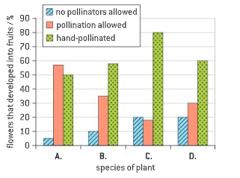Debora M Primrose Solutions for Chapter: Practice Exam Papers, Exercise 1: PRACTICE EXAM PAPERS
Debora M Primrose Biology Solutions for Exercise - Debora M Primrose Solutions for Chapter: Practice Exam Papers, Exercise 1: PRACTICE EXAM PAPERS
Attempt the practice questions on Chapter 16: Practice Exam Papers, Exercise 1: PRACTICE EXAM PAPERS with hints and solutions to strengthen your understanding. Oxford IB Prepared Biology IB Diploma Programme solutions are prepared by Experienced Embibe Experts.
Questions from Debora M Primrose Solutions for Chapter: Practice Exam Papers, Exercise 1: PRACTICE EXAM PAPERS with Hints & Solutions
The diagram shows the formation of Okazaki fragments in the replication of DNA in prokaryotes.

Why is the formation of Okazaki fragments necessary during replication?
What occurs during chemiosmosis?
The diagram shows two stems, one untreated and the other placed in ink for a day.

What causes the difference in these stems?
Scientists investigated the pollination of four species of plants. Each of the species was treated in three ways: some plants had their flowers covered to exclude pollinators, other plants were not manipulated, allowing birds to pollinate them, and a third group was pollinated by hand using a paintbrush. The percentage of the total flowers that developed into fruit was recorded.

Which species of plant is most efficiently pollinated by birds?
A student carried out an investigation comparing the growth of 100 cress seedlings in each of two different environmental conditions. When processing the data collected the student carried out a t-test. Looking up the calculated value of t in the appropriate table gave a probability value between 0.15 and 0.25. What is the conclusion drawn from this result?
What is punctuated equilibrium?
What is the source of glucose in the fluid flowing in the Bowman's capsule?
What happens immediately after the penetration of the sperm into the egg?
